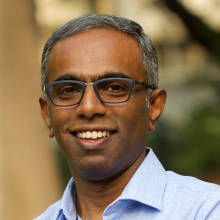AI has leapt from the lab to the living room, the boardroom, and the back office — often faster than we can grasp its effects. New models arrive with dizzying speed. Businesses adopt them wholesale. Yet in the rush to deploy, one crucial question is often missed: whose lens does this AI use to see the world?
That lens is shaped, more than we realise, by language. Periyar, the Tamil social reformer, once said: “The love of one’s tongue is the foremost of all loves.” He wasn’t being sentimental. He was pointing to a truth we still underestimate: language is not just a set of words; it’s a worldview. Lose a language and you lose a way of thinking, a rhythm of living, a map of meaning.
UNESCO estimates that over 40% of the world’s 7,000 languages are endangered, with one disappearing every two weeks. India — with 22 scheduled languages, over 780 indigenous tongues, and hundreds more spoken in markets, songs, and stories — is home to dozens at risk. The loss is not just cultural; it’s cognitive.
Language and the Mind
Noam Chomsky called language “a mirror of the mind.” Language doesn’t simply label things we already know; it shapes how we think. The structures of our minds are reflected in the structures of our languages.
If a language offers five words for “river,” it’s because the culture has five distinct relationships with water. If it has an untranslatable term for a pause in music — like thairaav — it’s because that pause matters enough to name. Lose the language, and you lose the frame of mind that created that word.
That is why this AI moment should give us pause. For the first time, we’re building systems that will speak to billions — and often, speak for them. But whose mental maps are they carrying?
AI: Multilingual, Monocultural
In the past year, AI has moved from innovation labs to executive dashboards. Versions of large language models (LLMs) now roll out almost seasonally, promising sharper reasoning, smoother dialogue, fewer hallucinations. Businesses are deploying them at speed — in customer service, marketing, HR, supply chains.
But speed can blind. Few ask: what cultural lens are these systems using? Often, that question surfaces only after rollout — after complaints, after customer churn.
Consider Klarna, the global payments company. It replaced hundreds of human customer service roles with AI, boasting lightning-fast replies in dozens of languages. Fourteen months later, they were rehiring. The AI could translate words — but only in one cultural idiom. Across 35 markets, that mismatch proved costly.
When AI Speaks One Cultural Language
Research by Columbia University and by Shav Vimalendiran, founder of SAMMY Labs, mapped major LLMs onto the Inglehart–Welzel Cultural Map — which plots societies along two dimensions:
- Traditional → Secular-rational (from reverence for religion, authority, and family ties to autonomy and scepticism of tradition)
- Survival → Self-expression (from security and conformity to diversity, creativity, and individual freedom)
The finding? Every major LLM clusters in the Protestant Europe/English-speaking quadrant. They can speak 35 languages, but they think in one.
Here’s a visual from Tey Bannerman’s LinkedIn post that makes this clear, showing exactly where major AI models are positioned. It’s a reminder that these systems don’t just translate words — they carry the worldview of where they were built.
The reason is structural: LLM performance depends heavily on how much digital data exists for a language — and for most languages of the Global South, that pool is far smaller. Without intervention, AI could deepen digital divides, marginalising low-resource languages and the cultures they carry.
Language ≠ Localisation
In India, some early efforts are bridging this gap.
Karya, a non-profit, builds Kannada datasets rich in dialects, idioms, and the rhythm of natural speech — aiming for AI that feels like it belongs in the community it serves.
In Tamil Nadu, the Vidhai Project sources genuine Tamil texts, annotates them for nuance, and even adapts tokenisation to respect Tamil’s complex morphology.
Zoho founder Sridhar Vembu has long argued: “End the mentality of English as a status symbol… Only the elite’s commitment to revive and honour Indian languages will bring real transformation.”
These join initiatives like AI4Bharat’s IndicTrans2 and IndoWordNet. They show the issue isn’t technical capability — it’s collective intent.
The Missing Metric: Cultural Intelligence
Businesses measure AI by accuracy, speed, and cost. But they rarely measure cultural intelligence — how well a system understands and respects the people it serves.
This isn’t “soft.” It shapes trust, adoption, and loyalty. A chatbot in rural Odisha might have perfect Odia grammar yet use a tone that alienates users. A farming tool in Maharashtra might translate advice into Marathi but miss the proverbs and terms farmers actually use — losing the embedded wisdom of generations.
Cultural intelligence should be a primary performance metric, on par with accuracy and uptime. Without it, AI risks being technically correct but practically irrelevant — and irrelevance is expensive.
India’s Opportunity
India’s diversity makes a single “default” style impossible. We have 22 official languages, 122 major ones, and over 1,500 mother tongues. Add etiquette, hierarchy, and local metaphors, and you see why language alone isn’t localisation.
If we don’t adapt AI for our contexts, we outsource our cultural operating system to where these models are built. That’s not just a cultural loss; it’s a business risk — a “cultural tariff” in lost relevance and user trust.
We could lead the world in context engineering — building AI fluent in the lived realities behind our languages. We have the scale, talent, and diversity. What we lack is urgency.
Just as we leapfrogged in mobile data, we could leapfrog here — designing AI that respects Marathi and Malayalam, Hindi and Haryanvi alike.
From Scaling to Thairaav
Back to thairaav. I first heard it from Satish Pradhan, a thought leader and a fellow Founding Fuel contributor. In Hindustani classical music, it’s the slow, deliberate exposition at the start of a raga — an unhurried unfolding where each note is savoured. Not delay, but depth.
As India marks another Independence Day, it’s worth recalling that independence is not a one-time event. Political freedom came first, economic strength followed. The next frontier is cultural independence — ensuring we’re not just passive users of systems shaping our future, but co-creators.
Thairaav has no neat English equivalent — and that’s the point. It symbolises the untranslatable richness AI risks flattening if we chase only speed. In business, thairaav means pausing before deploying, testing for cultural fit as rigorously as for technical accuracy.
True independence will mean AI that not only speaks our languages but carries our silences, our pauses, and our ways of seeing. That is what will make it truly ours.
Dig Deeper
The Ubuntu of AI: South Africa’s Moral Imagination: Why the world needs Ubuntu thinking in the age of AI. By Sundeep Waslekar



